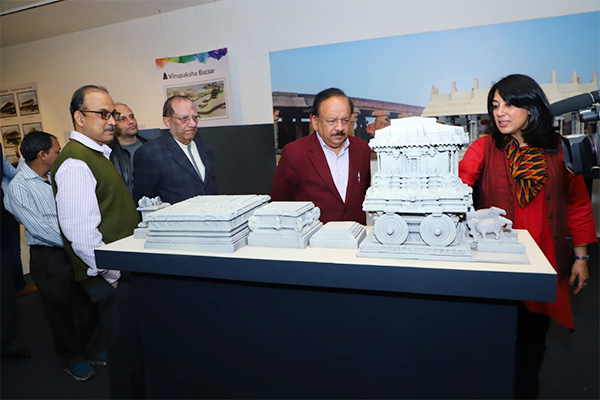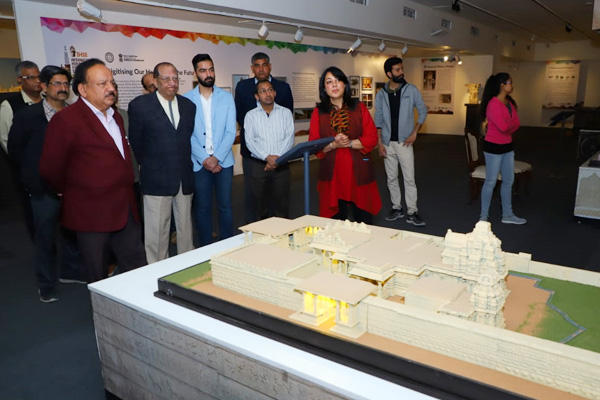
Union Minister of Science and Technology and Earth Sciences, Health and Family Welfare Dr. Harsh Vardhan, who visited the ongoing International Heritage Exhibition at the National Museum on February 18, 2020, described the digital conservation as interesting, educative and important.
“The exhibition has been disseminating the essence of ‘Incredible India’ in real sense. This helps in conserving damaged historical monuments in its original form for the young generation and researchers, and there is a need to make it a permanent exhibition”, Dr. Harsh Vardhan pointed out.
The digital conserved monuments have been taking visitors to the old era of rich architectural techniques. One can watch these digitally conserved monuments and other heritage sites while sitting at home and feel the importance of the monuments.
Dr. Harsh Vardhan added that there is a dire need to make this exhibition comprehensive by capturing the heritage from regions of the country. The exhibition will serve as a bridge between the past and future and will make the next generations aware of the rich cultural values and architectural techniques while promoting the concept of digital India. This will also help the new generation to learn to move ahead in conserving the monuments and will also attract tourists from all parts of the country and abroad.
The Department of Science and Technology has supported indigenous technologies to digitally preserve Indian heritage by focusing on the UNESCO world heritage sites like Hampi, Karnataka and also translate and enhance of some of the proven technologies through digital outcomes of exhibited at the Museum through initiatives like Indian Digital Heritage (IDH) and Indian Heritage in Digital Space (IHDS). Dr. Harsh Vardhan said that the Department of Science and Technology will continue to provide financial assistance for such projects.

The exhibition is a rare public display of digital preservation work undertaken in India using cutting edge Augmented Reality, Virtual Reality, Mixed Reality, and Artificial Intelligence technologies. The exhibition also showcases 3D fabricated models of five Indian monuments - Kashi Vishwanath, Taj Mahal, Sun Temple of Konark, Rani Ki Vav, Patan in Gujarat and Ram Chandra Temple in Hampi, Karnataka - with interactive virtual walk-throughs and projection mapping, and a room-scale 3D model of a Hampi Temple, with AR, VR, and Holographic interactions.
The exhibition has been going on for the last one month, and more than 5,000 visitors have enjoyed this unique show. It is scheduled to continue till February 23, 2020. Dr. Harsh Vardhan described it as a unique project of the Department of Science and Technology (DST) and underlined the need to make it a permanent structure. He appealed to school teachers and parents to bring children to witness the rich monumental characteristics being displayed in the exhibition. The exhibition has earned laurels from the UNESCO and other global organizations.
The exhibition is showcasing five mixed-reality installations called ‘ViRaasat,’ consisting of 3D printed, scale models of different monument complexes. These installations combine multiple technologies, which can be used by a visitor to interact with the physical models and experience personalized, realistic virtual walkthroughs of each of these heritage sites, and get information about their various facets. Dr. Anupma Malik, CEO of Vizara Technologies Pvt. Ltd, a technology start-up under the incubation of IIT Delhi, stated that a large number of people are coming to see the exhibition, and interest in it is increasing.
Under the project, damaged Historical Monument and extinct art forms like dance are being conserved for the future generation. The process includes laser scanning and mapping of the monument and preparation of the digital format of the monuments based on the available historical facts.
The exhibition can help initiate and nurture research in the frontier areas of digital heritage with specific reference to problems of the Indian context. It can also create a crowd-sourcing framework for building digital collections of heritage resources through the participation of the public and a mechanism to store, curate, and distribute multi-media digital resources and assets for unrestricted access to support cross-disciplinary research in Indian heritage. It also creates an innovation ecosystem to translate outcomes of the research to tangible products for propagating the spirit of indigenous culture and knowledge.






























